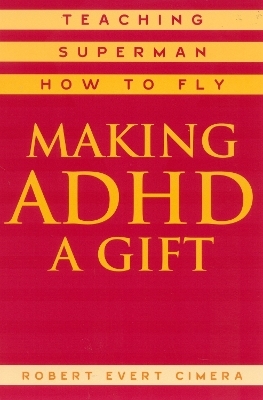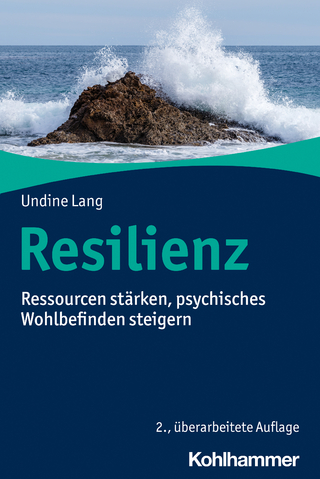
Making ADHD a Gift
Rowman & Littlefield Education (Verlag)
978-0-8108-4318-9 (ISBN)
Making ADHD a Gift explains, in everyday language, what ADHD is, how it is diagnosed, and how this condition can affect people throughout their lifetime. It also outlines methods of developing and assessing teaching strategies that can help individuals with ADHD both at home and at school. Unlike other texts, this book takes a positive look at having Attention Deficit Hyperactivity Disorder. Rather than trying to repress the characteristics of ADHD, Making ADHD a Gift advocates that individuals with ADHD use their disorder to maximize attention span, improve social skills, harness impulsivity, and turn hyperactivity into periods of extreme productivity. In addition to providing teaching strategies and accommodations for ADHD students, the book also examines issues unique to children, adolescents, and adults who have been diagnosed with this disorder. Methods are described to help adolescents with ADHD cope with the associated problems of depression and substance abuse, and to help adults manage the marital and employment difficulties that often accompany ADHD. There is additional helpful information about the benefits and side effects of medication, cultural factors that could cause misdiagnoses, forming support groups, and resources for parents and teachers of ADHD students.
Robert Evert Cimera, an assistant professor of Special Education at the University of Wisconsin at Oshkosh, was diagnosed with ADHD at an early age.
Part 1 Preface Part 2 1 An Overview of Attention Deficit Hyperactivity Disorders Chapter 3 Case Study: Mark Chapter 4 Introduction Chapter 5 What are "Attention Deficit Hyperactivity Disorders"? Chapter 6 What Causes Attention Deficit Hyperactivity Disorders? Chapter 7 How Are Attention Deficit Hyperactivity Disorders Diagnosed? Chapter 8 How Are Attention Deficit Hyperactivity Disorders Treated? Chapter 9 What Other Conditions Are Associated With ADHD? Chapter 10 What Are the Primary Conditions of ADHD? Chapter 11 Applying What You Have Learned Part 12 2 Methods of Addressing Inattention Chapter 13 Case Study: Stacey Chapter 14 How Can Inattention be a Problem? Chapter 15 How Can the Environment Affect Inattention? Chapter 16 How Can Teaching Strategies Affect Inattention? Chapter 17 What Skills Are Needed to Improve Inattention? Chapter 18 Applying What You Have learned Part 19 3 Methods of Addressing Impulsivity Chapter 20 Case Study: Robert Chapter 21 How Can Impulsivity Be a Problem? Chapter 22 How Can the Environment Affect Impulsivity? Chapter 23 How Can Teaching Strategies Affect Impulsivity? Chapter 24 What Skills Are Needed to Reduce Impulsivity? Chapter 25 Applying What You Have Learned Part 26 4 Methods of Addressing Hyperactivity Chapter 27 Case Study: Freya Chapter 28 How Can Hyperactivity Be a Problem? Chapter 29 How Can the Environment Affect Hyperactivity? Chapter 30 How Can Teaching Strategies Affect Hyperactivity? Chapter 31 What Skills Are Needed to Improve Hyperactivity? Chapter 32 Applying What You Have Learned Part 33 5 Methods of Addressing Social Skills Chapter 34 Case Study: Raymond Chapter 35 How Can Inappropriate Social Skills be a Problem? Chapter 36 How Can the Environment Affect Social Skills? Chapter 37 How Can Teaching Affect Social Skills? Chapter 38 What Skills Are Needed to Improve Social Behavior? Chapter 39 Applying What You Have Learned Part 40 6 Strategies for Children With ADHD Chapter 41 Case Study: Bobby Chapter 42 What is ADHD Like during Childhood? Chapter 43 How Can You Help Families? Chapter 44 How Can You Teach Children With ADHD? Chapter 45 Applying What You Have Learned Part 46 7 Strategies for Adolescents with ADHD Chapter 47 Case Study: Paul Chapter 48 What is ADHD Like during Adolescence? Chapter 49 How Can You Increase a Student's Self-Esteem? Chapter 50 How Can You Help Students Gain Independence and Control? Chapter 51 Applying What You Have Learned Part 52 Strategies for Adults with ADHD Chapter 53 Case Study: Candace Chapter 54 What is ADHD Like during Adulthood? Chapter 55 How Can You Prepare Students for Continuing Education and Employment? Chapter 56 How Can You Prepare Students for Marriage and Intimacy? Chapter 57 Applying What You Have Learned Part 58 9 Developing, Implementing, and Assessing Educational Programs Chapter 59 Introduction Chapter 60 How Do I Determine the Needs of My Students? Chapter 61 What Are Appropriate Goals for My Students? Chapter 62 How Do I Figure Out What Motivates My Students? Chapter 63 How Can I Help My Students Reach Their Goals? Chapter 64 How Can I Tell if the Education Plans Are Helping My Students? Chapter 65 Summary Part 66 10 Resources for Teachers, Parents, and Individuals with ADHD Chapter 67 Books for Teachers and Other Professionals Chapter 68 Books for Parents and Individuals With ADHD Chapter 69 Journals Magazines and Newsletters Chapter 70 Internet Resources Chapter 71 Videotapes Chapter 72 Organizations and Support Groups Part 73 Boxed Discussions Chapter 74 Cultural Diversity and ADHD Chapter 75 Identifying Depressed Students Chapter 76 Identifying Students with Sleep Difficulties Chapter 77 Collaborating with Reluctant Parents or Teachers Chapter 78 ADHD and the Perception of Time Chapter 79 Detecting Drug and Alcohol Use Chapter 80 Forming a Support Group Chapter 81 Reinforcing Appropriate Behavior Part 82 References Part 83 About the Author
| Erscheint lt. Verlag | 24.11.2002 |
|---|---|
| Verlagsort | Lanham |
| Sprache | englisch |
| Maße | 163 x 228 mm |
| Gewicht | 263 g |
| Themenwelt | Sachbuch/Ratgeber ► Gesundheit / Leben / Psychologie ► Lebenshilfe / Lebensführung |
| Sozialwissenschaften ► Pädagogik ► Sonder-, Heil- und Förderpädagogik | |
| ISBN-10 | 0-8108-4318-8 / 0810843188 |
| ISBN-13 | 978-0-8108-4318-9 / 9780810843189 |
| Zustand | Neuware |
| Haben Sie eine Frage zum Produkt? |
aus dem Bereich


